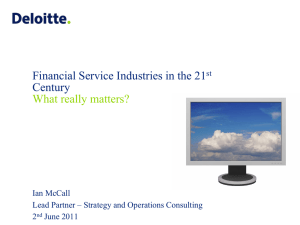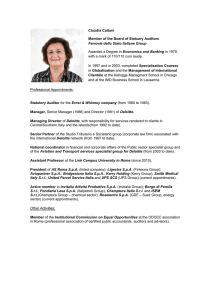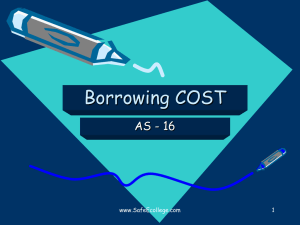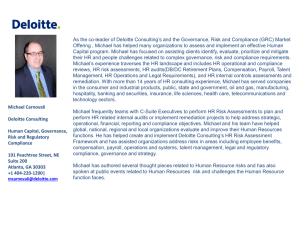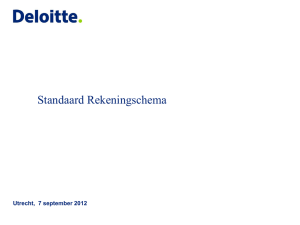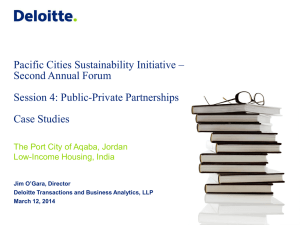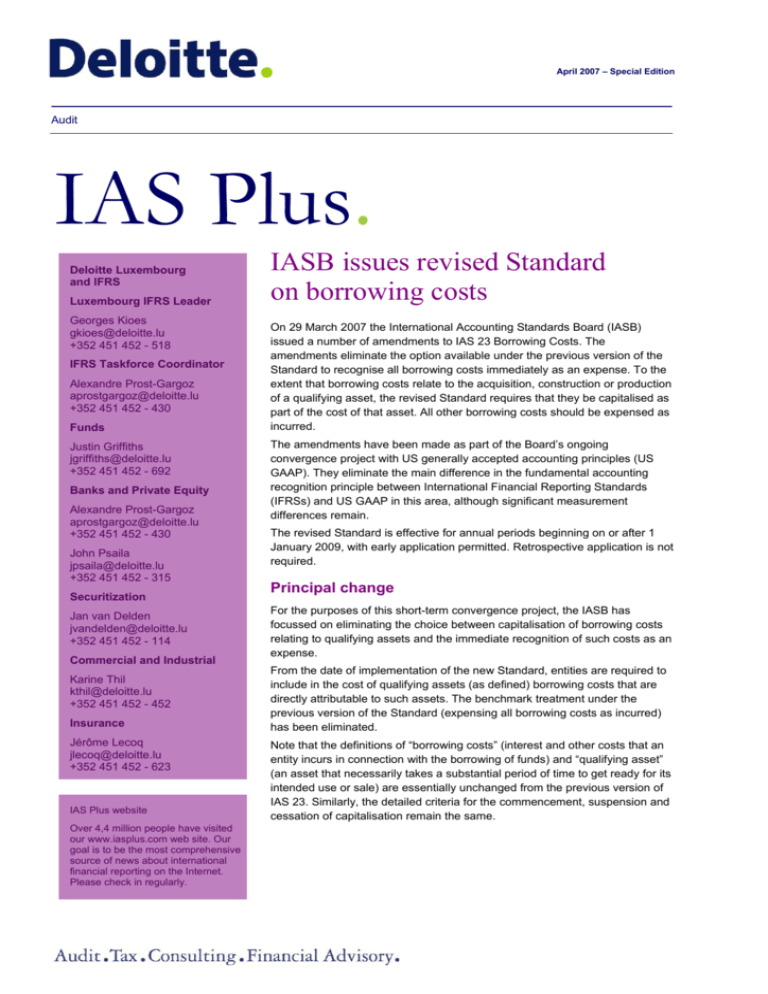
April 2007 – Special Edition
Audit
IAS Plus.
Deloitte Luxembourg
and IFRS
Luxembourg IFRS Leader
Georges Kioes
gkioes@deloitte.lu
+352 451 452 - 518
IFRS Taskforce Coordinator
Alexandre Prost-Gargoz
aprostgargoz@deloitte.lu
+352 451 452 - 430
Funds
Justin Griffiths
jgriffiths@deloitte.lu
+352 451 452 - 692
Banks and Private Equity
Alexandre Prost-Gargoz
aprostgargoz@deloitte.lu
+352 451 452 - 430
John Psaila
jpsaila@deloitte.lu
+352 451 452 - 315
Securitization
Jan van Delden
jvandelden@deloitte.lu
+352 451 452 - 114
Commercial and Industrial
Karine Thil
kthil@deloitte.lu
+352 451 452 - 452
Insurance
Jérôme Lecoq
jlecoq@deloitte.lu
+352 451 452 - 623
IAS Plus website
Over 4,4 million people have visited
our www.iasplus.com web site. Our
goal is to be the most comprehensive
source of news about international
financial reporting on the Internet.
Please check in regularly.
IASB issues revised Standard
on borrowing costs
On 29 March 2007 the International Accounting Standards Board (IASB)
issued a number of amendments to IAS 23 Borrowing Costs. The
amendments eliminate the option available under the previous version of the
Standard to recognise all borrowing costs immediately as an expense. To the
extent that borrowing costs relate to the acquisition, construction or production
of a qualifying asset, the revised Standard requires that they be capitalised as
part of the cost of that asset. All other borrowing costs should be expensed as
incurred.
The amendments have been made as part of the Board’s ongoing
convergence project with US generally accepted accounting principles (US
GAAP). They eliminate the main difference in the fundamental accounting
recognition principle between International Financial Reporting Standards
(IFRSs) and US GAAP in this area, although significant measurement
differences remain.
The revised Standard is effective for annual periods beginning on or after 1
January 2009, with early application permitted. Retrospective application is not
required.
Principal change
For the purposes of this short-term convergence project, the IASB has
focussed on eliminating the choice between capitalisation of borrowing costs
relating to qualifying assets and the immediate recognition of such costs as an
expense.
From the date of implementation of the new Standard, entities are required to
include in the cost of qualifying assets (as defined) borrowing costs that are
directly attributable to such assets. The benchmark treatment under the
previous version of the Standard (expensing all borrowing costs as incurred)
has been eliminated.
Note that the definitions of “borrowing costs” (interest and other costs that an
entity incurs in connection with the borrowing of funds) and “qualifying asset”
(an asset that necessarily takes a substantial period of time to get ready for its
intended use or sale) are essentially unchanged from the previous version of
IAS 23. Similarly, the detailed criteria for the commencement, suspension and
cessation of capitalisation remain the same.
April 2007 – Special Edition
New scope exclusions
Qualifying assets measured at fair value
Qualifying assets measured at fair value (such as biological assets accounted
for under IAS 41 Agriculture) are excluded from the scope of the Standard.
The measurement of such assets will not be affected by the amount of
borrowing costs incurred during their construction/ production. To require
entities to move to a policy of capitalisation would force them to change their
systems, only to then write off the capitalised borrowing costs when
remeasuring the asset to fair value. Note, however, that this exclusion does
not prohibit entities following the capitalisation approach in respect of such
assets if they choose to do so as a matter of accounting policy (provided that
the assets meet the definition of “qualifying”).
Inventories that are manufactured, or otherwise produced, in
large quantities on a repetitive basis
The second scope exclusion introduced in the revised Standard relates to
inventories that are manufactured, or otherwise produced, in large quantities
on a repetitive basis. Where such inventories take a substantial period to get
ready for sale (e.g. maturing whisky), capitalisation of directly attributable
borrowing costs is not required. This exception is allowed on the basis that the
costs involved in capitalisation (e.g. as a result of difficulties in allocating
borrowing costs to inventories and monitoring them until the inventory is sold)
would most likely exceed the potential benefits.
Again, this exclusion from the scope of the Standard does not prevent entities
that elect to do so following a capitalisation policy in respect of such
inventories, provided that the general conditions for capitalisation are met.
Convergence with US GAAP
The IASB’s principal objective in amending IAS 23 is to achieve convergence
in principle with US GAAP. By removing the option to expense all borrowing
costs, the revisions address the main difference between IAS 23 and the US
Statement of Financial Accounting Standards (FAS) 34 Capitalization of
Interest Cost.
However, other differences remain – in particular regarding the definition of
borrowing costs that are eligible for capitalisation, the definition of qualifying
asset, and the detailed calculation of the amount to be capitalised. Therefore,
even after the amendments to IAS 23 have been adopted, in many cases the
amount capitalised under IFRSs will not be the same as the amount that would
be capitalised under US GAAP.
Effective date and transitional provisions
The revised Standard is effective for annual periods beginning on or after 1
January 2009, with early application permitted. If an entity applies the
amendments for a period beginning before 1 January 2009, that fact should be
disclosed.
The amendments are generally to be applied prospectively to borrowing costs
relating to qualifying assets for which the commencement date for
capitalisation is on or after the effective date of the revised Standard.
Therefore, if an entity has previously followed an accounting policy of
immediately recognising all borrowing costs as an expense:
2
•
it is not required to retrospectively restate its financial statements for borrowing
costs incurred on qualifying assets before the effective date of the Standard;
•
nor is it required to apply the capitalisation policy to borrowing costs incurred
subsequent to the effective date on projects that had commenced (i.e. that had
met IAS 23’s criteria for commencement of capitalisation) before the effective
date.
April 2007 – Special Edition
For example, Entity A has 3 ongoing construction projects:
Project 1
Project 2
Project 3
Date of commencement of capitalisation 01/01/07
under IAS 23
01/01/08
01/01/09
Borrowing costs incurred prior to 1
January 2009
CU100
CU50
CU10
Borrowing costs incurred on or after 1
January 2009
Nil
CU50
CU90
Borrowing costs required to be
capitalised under IAS 23 (Revised)
Nil
Nil
CU90
However, an entity may choose to designate an earlier date for adoption of the
revised Standard – such that the amendments would be applied to all
qualifying assets for which the commencement date for capitalisation is on or
after that earlier designated date. In the example above, the entity could
designate 01/01/07 as the date from which the amendments would be applied
– and, in its financial statements in the year in which the amendments are first
adopted, could retrospectively capitalise the borrowing costs incurred on
Projects 1 and 2 from that date to the commencement of the current reporting
period.
First-time adoption
IFRS 1 First-time Adoption of International Financial Reporting
Standards has been amended to allow first-time adopters to apply the same
transitional provisions as existing IFRS users, taking the ‘effective date’ to be
date of transition to IFRSs (where that is later than 1 January 2009).
Therefore, borrowing costs related to qualifying assets would be required to be
capitalised prospectively from the later of the date of transition to IFRSs and 1
January 2009. First-time adopters would also be permitted to designate an
earlier date from which the revised Standard could be applied prospectively.
For more information on Deloitte Touche Tohmatsu, please access our
website at www.deloitte.com
3
Deloitte refers to one or more of Deloitte Touche Tohmatsu, a Swiss Verein, its member firms, and their respective subsidiaries and affiliates.
Deloitte Touche Tohmatsu is an organization of member firms around the world devoted to excellence in providing professional services and
advice, focused on client service through a global strategy executed locally in nearly 140 countries. With access to the deep intellectual capital of
approximately 135,000 people worldwide, Deloitte delivers services in four professional areas—audit, tax, consulting and financial advisory
services—and serves more than 80 percent of the world’s largest companies, as well as large national enterprises, public institutions, locally
important clients, and successful, fast-growing global growth companies. Services are not provided by the Deloitte Touche Tohmatsu Verein, and,
for regulatory and other reasons, certain member firms do not provide services in all four professional areas.
As a Swiss Verein (association), neither Deloitte Touche Tohmatsu nor any of its member firms has any liability for each other’s acts or omissions.
Each of the member firms is a separate and independent legal entity operating under the names “Deloitte,” “Deloitte & Touche,” “Deloitte Touche
Tohmatsu,” or other related names
This publication contains general information only and is not intended to be comprehensive nor to provide specific accounting, business, financial,
investment, legal, tax or other professional advice or services. This publication is not a substitute for such professional advice or services, and it
should not be acted on or relied upon or used as a basis for any decision or action that may affect you or your business. Before making any
decision or taking any action that may affect you or your business, you should consult a qualified professional advisor.
Whilst every effort has been made to ensure the accuracy of the information contained in this publication, this cannot be guaranteed, and neither
Deloitte Touche Tohmatsu nor any related entity shall have any liability to any person or entity that relies on the information contained in this
publication. Any such reliance is solely at the user’s risk.
© Deloitte SA y2007y All rights reserved


